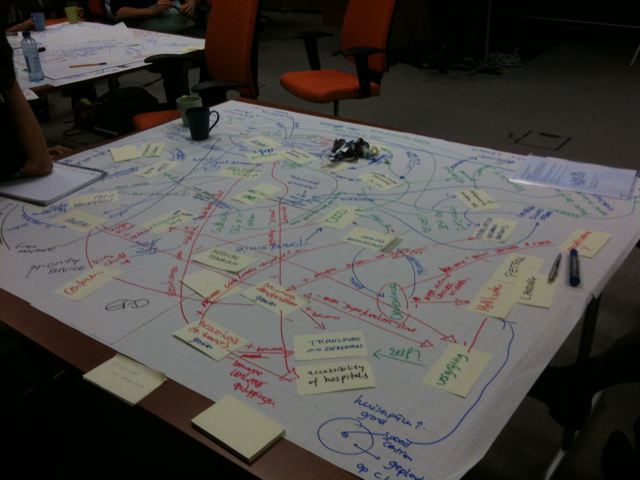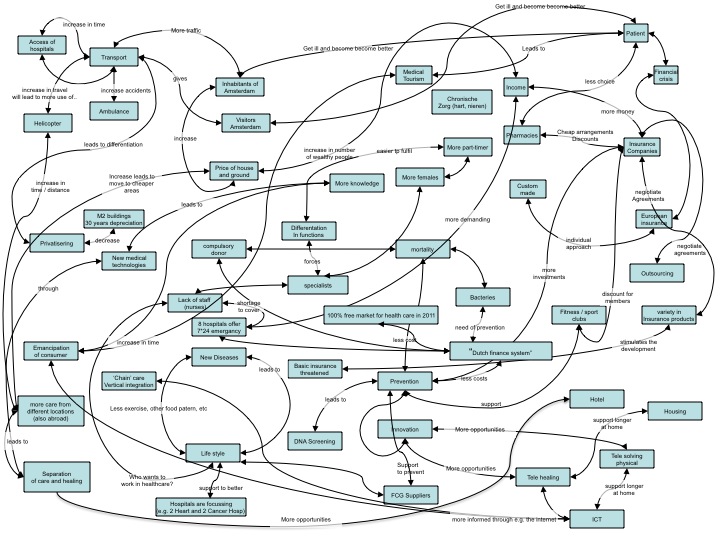The Future of Hospitals in Amsterdam in 2020
MBA09 team:
Peter Hoppesteyn
Roel Kock
Piotr Ptasinski
Miranda Tjiang
Marjoleine van der Zwan
"Work under construction. In case you have any questions, additions or comments, please do not edit these pages, but you are more than welcome to contact us.'
Scenarios:
I like the coaching session, and think you have a good command of the topic. The key challenge is now going to take the stories we talked about (and others) and put them together in NEW and interesting ways. Look at which stories you think fit well together and build the scenarios from that.
Good Luck - D
1. The new process
- efficiency in the process
- one appointment will only last 10 minutes and will contain different checks up depending on the complaint (basic intake related to the complaint)-> this does not necessarily exclude high technology and quality
- rethink the system
- different ways to use resources
- half price and better quality
- flexible employees
- lean and mean
- what are the set up costs
- what is easy to change
- differentiate and consolidate to optimize use of employees and expensive technology and tools
- more flow in the system, quick turn around
Story
The new hospital is run as a profit company, with patients in the role of products. The main focus in managing the hospital is on efficiencies, i.e. managing the costs per patient.
This system is patient oriented instead of doctor oriented.
2. Abandoning collective base insurance
- strong differentiation against market price
- insurance screens more severe
- selection at the entrance of the hospital
- decentralisation
- care activities take place at home -> custom made
- virtual hospital
- Teleprevention -> doctors advises and communication is based on the implanted chip that shows current status
- genetic screening-> downside: labelling and discrimantion
- conditions of use of technology need to be optimalized
Story In the early years of this century various trends can be spotted. All electronic devices are getting simpler but have more functions. All devices are getting smaller and cheaper. This trend in combination with the increase of the hospital buildings, and the hospital diseases, have to a new kind of health care. All most 90% of the basic processes can be done at the private home of the patient. Room are turned into 'operations room' in a minimum of the current required time. Telemonitoring does take care of the recovery afterwards.
The prevention of illness is also done by telemonitoring. The patient is constantly being monitored by his hospital (online service company) and incase of any threaths prevention actions are suggested to the patient. The prevention action can vary from online tips (by e-mail), service call from doctors or even vitits.
Because of a DNA file, family history and life monitor real pro-active prevention can be taken care of. A patient is never off line. Taken care of a patient is a 24 hours / 7 days a week service. All done remote.
3. Lifestyle "the health community system"
Keywords:
- Mind, body and soul
- Experience
- Gym, yoga exercise more, coach, facial, psychiatrist
- Role of insurance
- Incentive if you life your life “GOOD”
- Role pharmacy
- Biological food, healthy recepies
- FCG supplier
- Prevention
- Tailormade
- Healthcenter
- Knowledge of food (yellow carrot of India)
- How to get there is easy with public transport or own car
- Allignment, better communication with specialists that also are more centralised and consolidated their power
- More accessible
- Shops/Branding (Nike, Healthy food)
- Doctors (1e lijns)
- Dentists
- Chip, with personal file
Story
In the beginning of the 20th century people living in each other neighbourhood were most of the time closely related. And when people needed care there was always a family member or neighbour around. In those days the neighbourhood was a close community. Nowadays people do not even know one another in their neighbourhood. People live their live very individualistic and communities are fragmented and more established by activities or events e.g. a gym, mall, etc. Still the need of care is increasing especially because people are getting older. Above that the multicultural differences can add to further fragmentation. A community that can supply several services that will answer the common needs of men and woman, young and old, with any kind of cultural background.
Purpose
The HCC will take care of the mind, body and soul of all her members in the following way: to prevent, to inform, to advise and to guide along in the process from birth till death
Organised
There are no real hospitals anymore. Health care is organised differently:
The health community knows your profile, knows what is good for your mind, body and soul. If you are a member of Amsterdam you are a member of the HCC. The community provides all the tools and services to life your life at the utmost healthiest way. Every year a basic check up is done. There are no specialists working but 1e line doctors. Specialists are consolidated in their own centres. If something is not going well the HCC will take care of you and advise which process(es) are needed and have to take place and will make all the arrangements with the specialists that have their own centres.
Financed
The HCC is financed by the government, insurance and citizens of Amsterdam. If you are a citizen of Amsterdam you are a member and you need to pay to use the basic services. Other services and products are optional you can pay them yourself or via your insurance. Those shops/stores that supply the variable goods and services have to pay rent.
4. Solidarity within families
Shift from individualism to collectivism in Amsterdam
- Role of insurance
- Feeling of community
- Basic care is provided for everyone -> Same care for the same for everyone -> no difference between poor and rich
- Hospitals interiors are basic and simple, rooms are large and offer place for many patienst
- Family takes care of food, washing
- Consequence people will go abroad for health care that can provide higher services
- Creates a market for care takers
Story During the first years of the century the costs of healty care and the various hospitals have risen enourmously. This steep increase in costs of healty care made health care allmost unaffortable for the majority of the people of Amsterdam. To reduce costs most of the healthcare have been reduced from it's 'nice to have' services. In the hospitals 90% of all health care related actions are taken care off. The 'specialities' are being done in special hospitals. In the normal hospitals only the core product is being offert. The extra's can either be bought or taken care off yourself. This means to families will take care of the food, washing, entertainment of the patient. Even the supply of pills is done by the familie or friends. If these activities are not being taken care of a fine has to be paid. In and around the hosipitals extra services can be bought in from local entrepeneurs.
It is 2020 and we are living in Amsterdam. The number of people living in the capital of The Netherlands stabalised at around 750.000 many years ago. However, due to globalisation, the atractiveness of the city to foreigners, and relative high number of children per person of the allochtonous population compared to the number of children of the autochtonous population there is an increadible number of nationalities living on a relative small area. Therefore, the city is vulberable for pandemies. In 2015 the Bengalese flue had a major impact on the citizens (and the economy) of Amsterdam. When the pandemy peaked, more than one-third of the citizens of Amsterdam were sick. As a reaction to this disaster, people in Amsterdam started to focus on prevention of deseases. This resulted in beter public health, because people spend more time in sports schools than ever and healthy food is readily available. The last McDonalds in Amsterdam closed its doors one year ago! A drawback of this focus on prevention of deseases is that it is observed that human resistance to deseases significantly reduces. In the past people got a 'cold' or a flue every few years. Most people kept working or stayed at home for a couple of days. People recovered quite quickly. Nowadays, in general people have not been ill for a long time, but when the get a flue the need extra care and many times they end up in hospitals. In fact, the vulnerabiluty of the citizens of Amsterdam for a new pandemy is extremely high. Currently the Dutch government is investigating how to deal with this new threat.
Research Questions:
To be added
Driving forces:
• Innovation in health care
• Accessibility of hospitals in Amsterdam
• Biometrics
• Aging population
• Low cost of internet connections
• Continuously growing demand for new medical applications
• Consumer health informatics in the information age
• Emergence of new Technology Related Diseases
• Increasing empowerment of consumers
• Increasing Neglect of the Elderly
• Medicine
• Religion
• Segmentation
• Number of people in Amsterdam
• Number of visitors in Amsterdam
Summary of Interviews:
...To be discussed whether this can be put on the Wiki...
System Diagrams:
Systems Diagram: first version

Systems Diagram: final version
